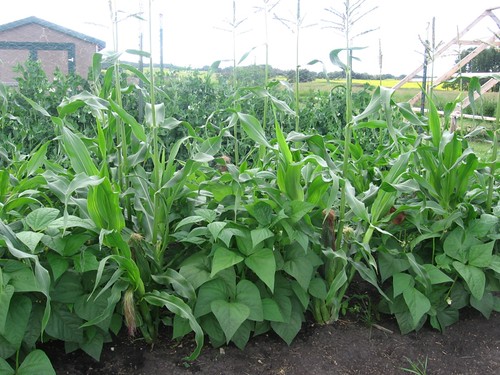After quite a bit of reading about companion planting, last spring I decided to try it.
Exactly what is companion planting, you ask? Companion planting is simply the process of planting different plants together that mutually benefit from having each other around. Native Americans used to do this with their corn, pole beans, and squash. They would make little mounds and plant several corn in the center. As the corn grew they would plant beans and squash around it. The corn provided the poles for the beans, the beans provided the nitrogen for the soil, and the squash acted as a mulch – preventing weeds and retaining moisture.
So I decided to give it a try – though not exactly as the natives did. I planted my corn in a block about 25 feet long and six feet wide with two feet between stalks. The corn was double planted and I planted two regular bush-type beans between the corn stalks. In the end, it looked like this…
Yesterday I picked the beans. When I compared the beans planted with the corn, they were much bigger than the same beans planted elsewhere in the garden. I was impressed. Companion planting does indeed work! So next year I thing I might try a few more combos.
Try These In Your Garden
Onion – plant with parsley to keep away onion fly
Celery – plant with cabbage, broccoli, or cauliflower to deter butterflies (grows well with beans, tomatoes, and leeks)
Asparagus – plant with tomatoes, parsley, or basil
Swiss Chard – plant with cabbage, broccoli, cauliflower, onions, lettuce, or herbs – do not plant with string beans
Beets – plant with kohlrabi, carrots, cucumber, lettuce, onions, cabbage, broccoli, or cauliflower – do not plant with string beans, dill, or fennel
Brussels Sprouts – plant with onions
Cabbage – plant with herbs, onion, garlic, peas, celery, potatoes, or beets
Kohlrabi – plant with beets or onions
Peppers – plant with basil, okra, or tomatoes
Cucumber – plant with corn, sunflowers, peas, beans, beets, or carrots
Pumpkin & Squash – Plant with corn, peas, or beans
Carrot – Plant with onions, annual flowers, lettuce, radishes, tomatoes, or peas – do not plant with anise and dill
Lettuce – Plant with cucumbers, onions, radishes, carrots, or dill (dill protects them from aphids)
Tomato – Plant with basil, parsley, and asparagus or French marigolds (French marigolds deter whiteflies)
Bean – plant with celery, corns, cabbage, broccoli, cauliflower or melons
Peas – plant with beans, root crops, potatoes, or corn
Radish – Plant with peas or lettuce
Potato – plant with corn, cabbage, beans, or marigolds
Spinach – plant with beans, peas, corn, and strawberries
Corn – Plant with beans, peas, sunflowers, cucumbers, squash, melons, and potatoes
